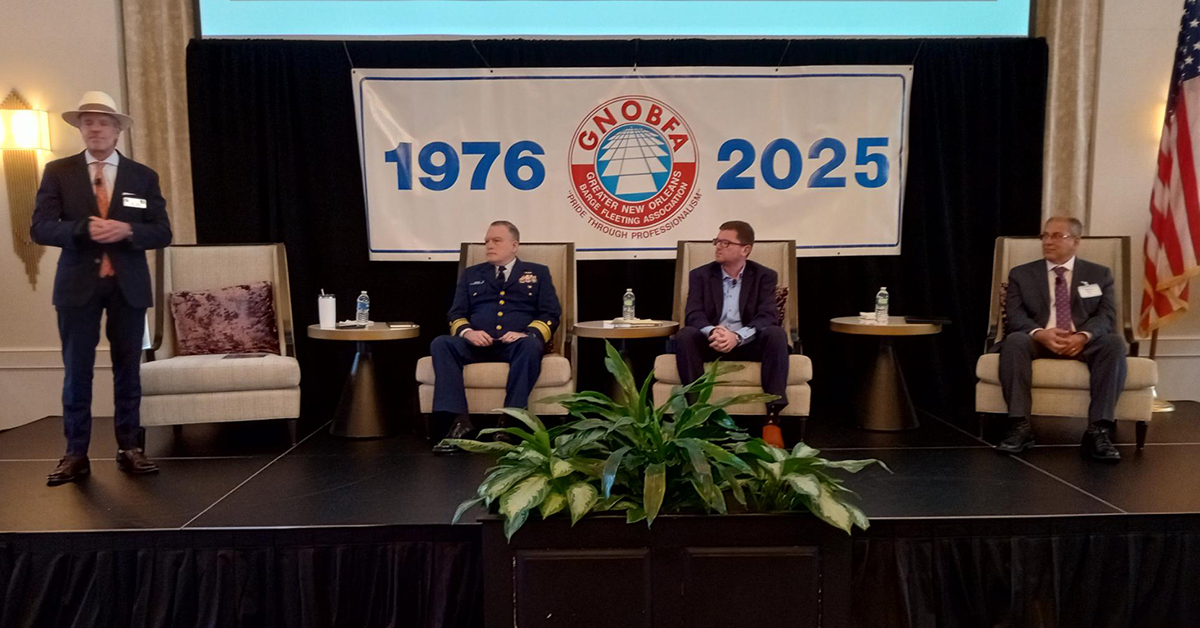As barge and fleeting interests in New Orleans braced themselves for the flood of high water that was moving downriver, attendees at the 41st annual River and Marine Industry Seminar held by the Greater New Orleans Barge Fleeting Association (GNOBFA) welcomed Rear Adm. David Barata, commander of the U.S. Coast Guard’s Eighth District, which includes the Lower Mississippi and a big chunk of the river system across many states.
The seminar was held at its longtime location, the Intercontinental Hotel, not far from the French Quarter. It featured a new, more open stage format, with panelists seated on easy chairs with a fern in front instead of in rows behind a table. GNOBFA has always stressed an informal give and take between panelists and attendees, with printed materials supplementing rather than dictating panel discussions, and the new format expanded on that tradition.
After opening remarks by GNOBFA President Karl Gonzales of Cooper Marine and seminar co-director Tommy Grantham of Ingram Capital Fleet Inc., seminar moderator Marc Hebert Jr. welcomed Barata, thanking him for his two years of close cooperation with industry over many high- and low-water events and weather emergencies.
Barata’s Three Challenges
Barata noted in his keynote speech that the Eighth District is a “heartland area and the crux of things” that embraces 3,500 marine terminals and 25,000 miles of waterways. He spoke on the “balance of opportunity and risk” that faces the inland industry from new technology and regulations, including cyber regulations.
Barata said he saw a triple challenge: increased demand for limited inland waterways space, increased desire for sustainability and the impact of new technologies. Demand for use of the maritime transportation system is increasing, from those using new fuels or seeking to promote aquaculture next to navigation channels.
“We have to move and regulate at the speed of industry,” he said, yet waterways infrastructure is aging and gets a “D” grade from civil engineers.
He referred to the allision of the cargo ship mv. Dali that collapsed a bridge in Baltimore’s harbor, leading to the re-routing of cargoes along the East Coast. In the case of a similar disaster in the Eighth District, Barata said, “We don’t have the luxury of re-distributing cargo flows like the East Coast did.”
He noted the many “good neighbors that help keep the system running,” as well as the aging dustpan dredges he observed the previous week aboard the low-water tour of the mv. Mississippi.
Barata was optimistic, though, noting the cutting of steel in April in Bayou La Batre, Ala., for the first of a fleet of Waterways Commerce Cutters (WCCs) for the Coast Guard, and he touted the use of AIS data in river facilities and “data-driven risk management models.”
Autonomous Vessels
One of the new challenges Barata noted was the increased interest in autonomous vessels. A panel including Rear Adm. Wayne Arguin, assistant commandant for prevention policy at Coast Guard headquarters, Joe Bussenger, director of Marine Recovery Operations at a new company called Relativity Space, and Pablo Meijia, director of autonomy at Metal Shark Boats, discussed the progress and future of marine autonomous vessels.
Bussenger previously worked at SpaceX, the first company to retrieve rockets using moored barges at sea, and he is doing a similar job for Relativity Space, which hopes to compete with SpaceX for rocket recovery contracts. Bussenger noted that, until SpaceX developed a way to reuse rocket stages, the cost of putting a network of satellites in space like the hundreds that support the Starlink system would have been prohibitive.
The barges that recover rockets for SpaceX have to be moored and all personnel moved safely away while the barge is monitored and controlled remotely from a shore station. Bussenger was one of the team members in the control room during those operations, and he noted that, with no crews aboard the barge, the remote team had to have “backups backing up the backups” to be able to respond to any scenario and avoid endangering anyone. He noted, “There is no human in the loop for auto-destruct” of the rockets during flight patterns. There are three separate methods of disconnecting the towboat from the recovery barge and “multiple redundancies” in control systems.
Arguin and his Coast Guard team are working on regulations for this new world of autonomous technology. He noted that “autonomous” doesn’t necessarily mean “crewless.” Cars already have cruise control, and planes fly much of their routes on automatic pilot. Both cases represent forms of autonomous movement. Nevertheless, he said, few would board an airplane with no pilots in the cockpit.
“It’s very challenging to replace a person,” he said.
Vessel regulations still require human lookouts aboard ships.
In the event of a maritime incident involving an autonomous crewless vessel, regulations have to take account of who would have liability. Would it be the remote operator, the owner or the equipment maker? These questions are still being worked out.
Arguin said crewless vessels were probably a long way off, although he understood they are being worked on in Europe. He speculated that autonomous systems might be good at doing menial tasks that require constant, steady vigilance to free a human operator to focus on risk management.
“Humans are good at making quick decisions with limited information and even under pressure,” he said.
Arguin said technology is moving at light speed, “especially with respect to AI, with advances being announced every day.”
Meijia described how Metal Shark, which has 28 years of experience designing autonomous vehicle software, has been developing and building autonomous vessels for the U.S. Navy and Marine Corps.
Last April, Metal Shark debuted “Prowler,” a versatile military craft combining multiple technologies to meet the current and near future warfighting requirements of the U.S. military and its allies. It is also debuting “Frenzy,” a high-performance, low-cost, amphibious micro-USV with a payload carrying capacity of up to 14 pounds.
Hypothetical Scenario
The April 10 program included a panel on jury trials, specifically on the rise of “huge” verdicts that juries can sometimes deliver.
Seminar organizers used a fictional hypothetical scenario to foreground the issues. In the scenario, a towboat with a crew of four, including a green deckhand, is pushing a tow of four tank barges loaded with ammonia. The tow strikes a bridge, causing an explosion that incinerates the deckhand, who is standing lookout. The other deckhand and pilot fall out of their bunks, with the pilot hitting his head. The captain radios the Coast Guard and pushes the barges against the shore. Two barges sink. The Coast Guard and state police arrive on the scene in minutes, remove the injured crewmembers and secure the scene. After 30 minutes, counsel for the towing company appears and demands that the Coast Guard stop questioning until he can confer with his client. The captain requests his own representation.
It is later learned that the radar was inoperative due to a missing part, and the operator’s towing safety manual was copied from another company, whose name is all over it. An empty narcotics bottle is discovered in the deceased deckhand’s luggage.
At the hospital, the deckhand and pilot refuse drug tests.
This scenario was the basis for several of the remaining panels, as they examined everything from how attorneys, insurance investigators and operators should conduct themselves in the immediate aftermath to questions of liability and coverage.
Importance Of Jury Trials
The jury trial panel featured several GNOBFA veterans, including defense attorney and Jones Walker partner Jeff Tillery, the Hon. Kurt Engelhardt, a magistrate judge of the Fifth Circuit, and Kyle Findley, a plaintiff’s attorney with Arnold and Itkin.
Engelhardt opened with a statement in favor of jury trials. He pointed out that the United States has 90 percent of all the jury trials in the world. The founders considered the right to a jury trial so important to democracy, he said, that they rated it above the right to vote. They put the right to a jury trial in the original text of the Constitution, while the right to vote was added in an amendment.
The jury selection process, called voir dire, is really a “de-selection” process, said Findley. Very opinionated potential jurors usually get excluded for cause. He added, “Most really good cases settle,” although those outcomes rarely get publicized. “Outsized verdicts happen when the parties can’t agree.”
Findley said that “over-prepared” corporate expert witnesses who challenge everything a plaintiff attorney says often hurt the defendants they are trying to serve. He would always prefer to settle a case because it provides certainty for his client, and “putting the case in a jury’s hands can be dangerous.” On the other hand, he said, tort reform “is not always a good thing because it can take discretion away from juries.”
Engelhardt said he closely examines books of notes jurors keep during trials, which are the court’s property, in order to learn more about how jurors think. “Those notes are often as good as the court reporter’s,” he remarked. All three panelists agreed that jurors “get it right most of the time,” and that most jury verdicts are reasonable, despite the occasional verdicts that seem outsized, get headlines and raise eyebrows.
Tillery spoke about how ordinary jurors, who are not experts on legal issues, look at the facts of a case. He said defense attorneys have to try to look at things from the jurors’ point of view. When he is defending a company against a claim of liability for injury or death, he will try to humanize the company and show that it acted reasonably. His goal is to keep any judgment awards reasonable. He would also try to have separate trials for injuries to the various plaintiffs to have the facts of their cases considered separately, to avoid sympathy for one to “bleed over” into other cases. Defense attorneys often have independent medical examiners look at plaintiffs, but Tillery said he doesn’t hope for too much from that. Findley said doctors “don’t disagree as much as you think they do.”
In the scenario, the time of death for the fictional deckhand who burned to death could be an important issue. Under the Jones Act, awards for pain and suffering can only cover the time before death. Tillery said he would also look at what the company’s employee manual says about refusing a drug test. Findley said he would try to have it excluded in the case of the injured pilot, since he was asleep in his bunk when his injury occurred.
Executive Order
The next panel discussed President Donald Trump’s recent executive order promoting a revival of America’s shipbuilding capabilities. Hebert noted that it includes many provisions of the SHIPS Act that was introduced last Congress but not passed. Arguin noted, “This is the first time I have seen this much attention devoted to maritime matters in my entire career.”
Section 3 orders the development of a Maritime Action Plan, and Section 4 deals with measures to revive the maritime industrial base. Section 5 covers recent recommendations of the U.S. trade representative regarding China’s shipbuilding capacities. Notably, the executive order did not impose fees on Chinese-built vessels of up to $1 million per visit to a U.S. port that had been recommended by the U.S. trade representative; those were strongly opposed by U.S. shippers, exporters and farmers.
Section 9 establishes a Maritime Security Trust Fund, and Section 10 offers incentives to improve financing for shipyards.
Section 11 establishes Maritime Prosperity Zones, and Section 12 orders a report on maritime industrial needs, including a review of the Port Infrastructure Development Program, whose grants may be subsumed in other programs.
The White House met on April 10 with a team that included Adm. Arguin to discuss the recommendations in the executive order. Many of the orders have a 180-day window.
Hebert said he believes the Maritime Action Plan will be ready by the end of the year and will pass Congress with bipartisan support before the mid-term elections. Large shipbuilders will get more grant opportunities, and more tax credits will be made available on the domestic shipbuilding side.
SASH Reporting Update
Arguin returned for a panel discussion updating the latest news on sexual assault and harassment (SASH) reporting. Jeff Lewis, a senior attorney adviser in the U.S. Coast Guard Judge Advocate General’s Office of Maritime and International Law in Washington, D.C., also took part.
Arguin reported that the Coast Guard has investigated 287 cases in total, including 104 involving sexual harassment, 15 of pure assault, 18 of sexual assault and 17 cases involving prior convictions that invalidated credentials. None of the cases referred to the Justice Department were adopted for criminal prosecution, Arguin said, so administrative penalties were used—i.e., credential revocation or denial. Those numbers include both blue-water and brown-water incidents; Arguin said the Coast Guard will break out those numbers separately at a later date. However, he said he doesn’t think the number accurately reflects the actual number of incidents.
Zero tolerance for SASH violations is important for recruiting the next generation of mariners, who need to know they will have a safe work environment, Arguin said. SASH policies and their execution also have implications for claims of unseaworthiness and negligence.
To a questioner who asked if there is a statute of limitation on reports of SASH, Arguin and Lewis both said “no.” Lewis added that while there are no time limits on reporting, there may be time limits on some actions that might be taken.
Arguin said that a legal definition of what constitutes “harassment” was included in the Coast Guard Authorization Act that did not pass in the last Congress, and it will be included in the 2025 authorization. He added, “If you discharge anyone due to a harassment situation, I need to know so we can look at his credentials.”
“If you are taking care of your crews, fine,” Arguin concluded. “If not, they will go to your competitor.”
Crowded River
During a panel discussion on how the newly formed Louisiana Ports and Waterways Investment Commission is improving coordination among Louisiana’s 41 ports, pilot Toby Wattigney of the New Orleans and Baton Rouge Steamship Pilots Association (NOBRA) said the Lower Mississippi River is increasingly jammed. It’s more difficult to find “parking spots” to anchor vessels waiting for berths. “There are very few places left to safety develop fleets and anchorages.” He quickly added that he is proud of the 99.9 percent safety record of Louisiana pilots who operate in the increasingly crowded conditions.
One issue, he said, is that the low-sulfur fuels mandated by climate rules make vessels more likely to lose power. He said Louisiana bridges need alarm systems, like the Baltimore Key Bridge system that saved lives after the mv. Dali allided with it. When he started as a pilot, 38 feet was the maximum draft for a ship. Now it’s 45 feet, headed toward 50 feet.
Wattigney noted that LNG facilities need anchorages, and he said the Pilottown anchorage has severe deficiencies.
Featured image caption A panel discusses automation and artificial intelligence at this years Greater New Orleans Barge Fleeting Association seminar. Panelist (from the left) include Marc Hebert, moderator and a partner at Jones Walker; Rear Adm. Wayne Arguin, assistant commandant for prevention policy for the U.S. Coast Guard; Joe Bussenger, director of marine recovery operations for Relativity Space; and Pablo Meijia, director of autonomy for Metal Shark Boats. (Photo by David Murray)




